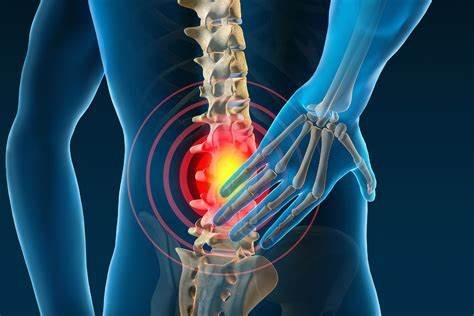Back pain is a common issue that many people experience at some point in their lives. It can range from a dull, constant ache to a sudden, sharp pain. The causes of back pain are varied and can include muscle strain, slipped discs, arthritis, and even emotional stress.

- Acute Back Pain:
- Short-term pain that lasts for a few days to weeks.
- Often caused by muscle strain, ligament sprain, or sudden movements.
- Chronic Back Pain:
- Long-lasting pain that persists for 3 months or more.
- Can be due to underlying conditions like degenerative disc disease, arthritis, or spinal stenosis.
- Radiating Back Pain:
- Pain that spreads to other areas of the body, such as the legs, is often due to nerve involvement (e.g., sciatica).
Common Causes of Back Pain:
- Muscle or Ligament Strain: Overuse, improper lifting, or sudden awkward movements can strain the muscles or ligaments in the back.
- Herniated or Bulging Discs: The soft discs between vertebrae can become damaged, pressing on nerves and causing pain.
- Arthritis: Conditions like osteoarthritis can lead to the narrowing of the space around the spinal cord, leading to pain and stiffness.
- Sciatica: Pressure on the sciatic nerve, often caused by a herniated disc, leading to pain that radiates down the legs.
- Postural Issues: Poor posture, especially while sitting, standing, or sleeping, can contribute to back pain.
- Osteoporosis: Weakened bones due to osteoporosis can cause fractures and back pain.
- Scoliosis: An abnormal curvature of the spine can lead to chronic back pain.
- Spinal Stenosis: Narrowing of the spinal canal, which can put pressure on nerves, leading to pain, numbness, or weakness.
Symptoms of Back Pain:
- Localized pain: Pain felt in a specific area of the back.
- Radiating pain: Pain that spreads to other parts of the body, such as the legs (sciatica).
- Numbness or tingling: This could suggest nerve involvement, particularly in conditions like sciatica.
- Muscle spasms: Sudden, intense muscle contractions that can occur with back injuries.
- Limited range of motion: Difficulty bending, twisting, or straightening the back.
Treatment for Back Pain:
- Rest and Activity Modification: While it’s important not to stay completely still, reducing physical activity during an acute flare-up can help. Avoid lifting heavy objects or strenuous movements.
- Physical Therapy: Exercises that improve posture, strengthen the back muscles, and increase flexibility can be effective in treating both acute and chronic back pain.
- Pain Relief: Over-the-counter medications like ibuprofen or acetaminophen can help reduce inflammation and relieve pain. Topical creams or gels may also be used for localized pain.
- Heat and Cold Therapy: Applying an ice pack in the early stages of back pain can reduce inflammation, while heat pads can help relax tense muscles.
- Massage: A therapeutic massage can help relieve tension in the muscles and promote blood flow to the affected area.
- Chiropractic Care: Spinal adjustments by a chiropractor may help alleviate certain types of back pain, particularly those related to misalignment of the spine.
- Surgery: In severe cases (such as with a herniated disc, severe arthritis, or spinal stenosis), surgery may be considered, though it is typically a last resort.
Prevention of Back Pain:
- Maintain a Healthy Weight: Excess weight puts additional strain on the back muscles and spine.
- Exercise Regularly: Activities like walking, swimming, or strengthening exercises for the core and back can help prevent back pain.
- Practice Good Posture: Avoid slumping when sitting or standing. When lifting, use your legs rather than your back.
- Use Ergonomic Furniture: If you sit for long periods, ensure that your workstation is ergonomically designed to support your spine.
- Sleep in a Proper Position: Use a firm mattress and avoid sleeping on your stomach. Consider sleeping on your side with a pillow between your knees.
When to See a Doctor:
- If the pain is severe, doesn’t improve with rest, or is accompanied by other symptoms like numbness, weakness, or difficulty controlling bladder or bowel functions, seek medical attention immediately.
- If back pain is caused by a fall, injury, or accident, or if there is unexplained weight loss or fever, consult a doctor.
